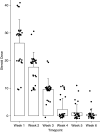Persistent Post-COVID-19 Interstitial Lung Disease. An Observational Study of Corticosteroid Treatment
- PMID: 33433263
- PMCID: PMC8086530
- DOI: 10.1513/AnnalsATS.202008-1002OC
Persistent Post-COVID-19 Interstitial Lung Disease. An Observational Study of Corticosteroid Treatment
Abstract
Rationale: The natural history of recovery from severe acute respiratory syndrome coronavirus 2 (SARS-CoV-2) remains unknown. Because fibrosis with persistent physiological deficit is a previously described feature of patients recovering from similar coronaviruses, treatment represents an early opportunity to modify the disease course, potentially preventing irreversible impairment.Objectives: Determine the incidence of and describe the progression of persistent inflammatory interstitial lung disease (ILD) following SARS-CoV-2 when treated with prednisolone.Methods: A structured assessment protocol screened for sequelae of SARS-CoV-2 pneumonitis. Eight hundred thirty-seven patients were assessed by telephone 4 weeks after discharge. Those with ongoing symptoms had outpatient assessment at 6 weeks. Thirty patients diagnosed with persistent interstitial lung changes at a multidisciplinary team meeting were reviewed in the interstitial lung disease service and offered treatment. These patients had persistent, nonimproving symptoms.Results: At 4 weeks after discharge, 39% of patients reported ongoing symptoms (325/837) and were assessed. Interstitial lung disease, predominantly organizing pneumonia, with significant functional deficit was observed in 35/837 survivors (4.8%). Thirty of these patients received steroid treatment, resulting in a mean relative increase in transfer factor following treatment of 31.6% (standard deviation [SD] ± 27.6, P < 0.001), and forced vital capacity of 9.6% (SD ± 13.0, P = 0.014), with significant symptomatic and radiological improvement.Conclusions: Following SARS-CoV-2 pneumonitis, a cohort of patients are left with both radiological inflammatory lung disease and persistent physiological and functional deficit. Early treatment with corticosteroids was well tolerated and associated with rapid and significant improvement. These preliminary data should inform further study into the natural history and potential treatment for patients with persistent inflammatory ILD following SARS-CoV-2 infection.
Keywords: COVID-19; fibrosis; interstitial lung disease; organizing pneumonia.
Figures




Comment in
-
A Role for Steroids in COVID-19-associated Pneumonitis at Six-Week Follow-Up?Ann Am Thorac Soc. 2021 Jun;18(6):1082-1083. doi: 10.1513/AnnalsATS.202101-048LE. Ann Am Thorac Soc. 2021. PMID: 33735603 Free PMC article. No abstract available.
-
Lungs after COVID-19: Evolving Knowledge of Post-COVID-19 Interstitial Lung Disease.Ann Am Thorac Soc. 2021 May;18(5):773-774. doi: 10.1513/AnnalsATS.202102-223ED. Ann Am Thorac Soc. 2021. PMID: 33929309 Free PMC article. No abstract available.
-
Should a Nonresolving Pneumonia Be Treated as an Organizing Pneumonia in Times of COVID-19?Ann Am Thorac Soc. 2021 Sep;18(9):1598. doi: 10.1513/AnnalsATS.202103-317LE. Ann Am Thorac Soc. 2021. PMID: 34129809 Free PMC article. No abstract available.
-
Not All Parenchymal Changes on Computed Tomography Are Interstitial Lung Disease.Ann Am Thorac Soc. 2021 Sep;18(9):1597. doi: 10.1513/AnnalsATS.202101-084LE. Ann Am Thorac Soc. 2021. PMID: 34129810 Free PMC article. No abstract available.
-
Use of Corticosteroid in Persistent Post-COVID-19 Interstitial Lung Disease.Ann Am Thorac Soc. 2021 Sep;18(9):1599. doi: 10.1513/AnnalsATS.202105-623LE. Ann Am Thorac Soc. 2021. PMID: 34191693 Free PMC article. No abstract available.
References
-
- Zhao W, Zhong Z, Xie X, Yu Q, Liu J. Relation between chest CT findings and clinical conditions of coronavirus disease (COVID-19) pneumonia: a multicenter study. AJR Am J Roentgenol. 2020;214:1072–1077. - PubMed
Publication types
MeSH terms
Substances
LinkOut - more resources
Full Text Sources
Other Literature Sources
Medical
Miscellaneous

